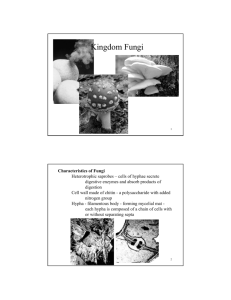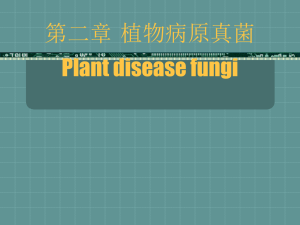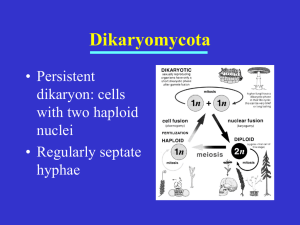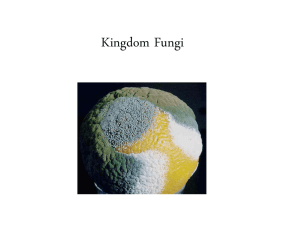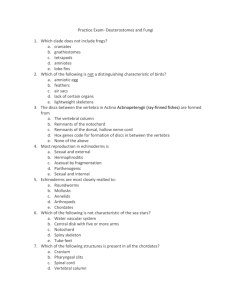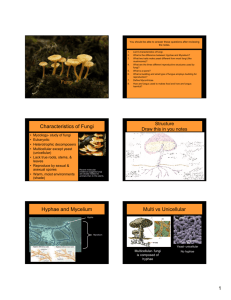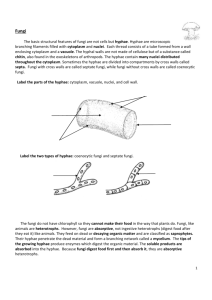Kingdom Fungi
advertisement
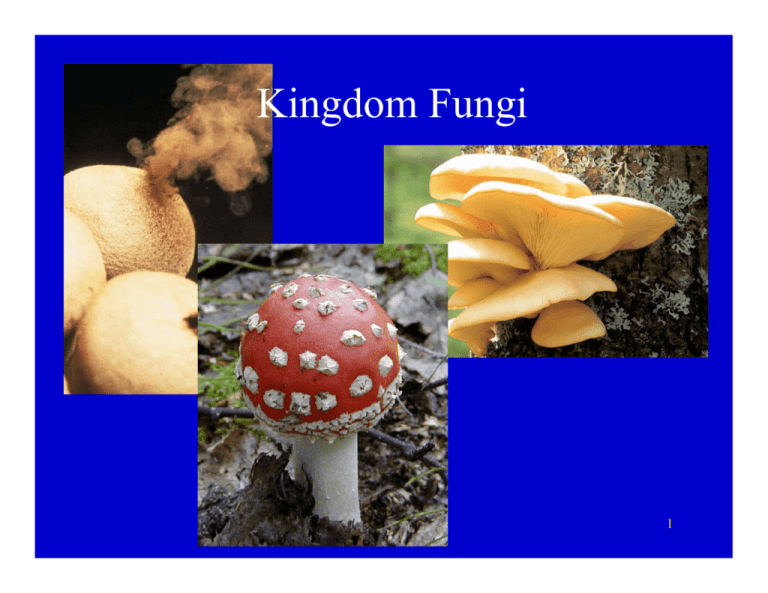
Kingdom Fungi 1 Characteristics of Fungi Heterotrophic saprobes – cells of hyphae secrete digestive enzymes and absorb products of digestion Cell wall made of chitin - a polysaccharide with added nitrogen group Hypha - filamentous body - forming mycelial mat each hypha is composed of a chain of cells with or without separating septa 2 Nuclear mitosis - all stages of mitosis go on within the nucleus - followed by nuclear division and then cell division Some fungi have a dikaryon stage - cells of two different hyphae fuse and the nuclei of each remain distinct within the new hypha 3 Reproduction in Fungi • Differ from most animals and plants in that each compartment of hypha can contain one, two or more nuclei – monokaryotic - each compartment has a single nucleus – dikaryotic - two distinct nuclei within each hyphae compartment • Possible for many nuclei to intermingle in common cytoplasm of fungal mycelium which can lack distinct cells – heterokaryotic – dikaryotic or multinucleate hypha has nuclei from genetically distinct individuals – homokaryotic – hyphae whose nuclei are genetically 4 similar to one another Fungi have both asexual and sexual reproduction Asexual • fragmentation (breakage) of hyphae can produce new mycelium • production of spores by modified hyphae - spores dispersed by wind Sexual always involves fusion of cells from different mating types (+/-) in some, the cells that fuse are gametes, in others the cells that fuse are part of hyphae in some, fusion produces a diploid zygote, in others the fusion produces a dikaryon, or heterokaryon fusion of nuclei within dikaryon produces diploid zygote nucleus meiosis of zygote produces haploid spores 5 meiosis N 2N gametes 6 N meiosis 2N N 7 nuclear fusion 2N meiosis N+N dikaryon N 8 Fungal Ecology Feeding - saprobes - feed on dead or living material - secrete digestive enzymes and absorb products of digestion some are important decomposers can digest lignin and cellulose of wood some are parasitic on living organisms athlete’s foot, ringworm, corn smut, rusts some are predatory - some can anesthetize and consume roundworms (our local oyster mushroom) some have mutualistic relationships with other organisms lichen = fungus + green alga fungus provides alga with some nutrients needed for photosynthesis - alga provides complex organic nutrients to fungus micorhizzal fungi - associate with plant roots and absorb nutrients from soil to aid plant 9 There are four major groups of fungi Chytridiomycota Zygomycota Basidiomycota Ascomycota 10 Phylum Chytridiomycota - 1000 species aquatic, flagellated fungi – most closely related to ancestors of all fungi – gametes are flagellated – has well developed sporophyte (diploid) stage 11 e.g. Allomyces - sporic meiosis with multicellular haploid stage (gametophyte) and multicellular diploid stage (sporophyte) 12 Phylum Zygomycota – 1050 species Bread molds and relatives Sexual and asexual reproduction common Hyphae without septa, except for separation of reproductive structures Has short diploid stage (zygosporangium) 13 e.g. Rhizopus - zygotic meiosis - multicellular haploid stage only 14 Phylum Basidiomycota – 22,000 species mushrooms, toadstools, rusts, smuts many species eaten many poisonous or semi-poisonous species has well developed dikaryotic stage the basidiocarp (mushroom) carries basidia on gills or in pores nuclei fuse within basidia and then produce basidiospores by meiosis 15 16 17 Phylum Ascomycota – 45,000 species – Most yeasts, truffles, morels Great diversity - includes many plant parasites – e.g. Dutch elm disease and chestnut blight Sometimes called cup fungi because of the shape of their reproductive structures Has well developed dikaryotic stage The ascocarp carries asci within cups Nuclear fusion occurs within ascus, meiosis follows producing ascospores Some species lack a sexual stage (e.g. Penicillium) 18 19 20 • Yeasts – unicellular - most reproduction is asexual and takes place by cell fission or budding • ferment carbohydrates - produce ethanol as byproduct • play a leading role in genetic research 21 Ecology of Fungi • Fungi are saprobes - heterotrophs that secrete digestive enzymes and absorb products of digestion. • some are important decomposers can digest lignin and cellulose of wood • some are parasitic on living organisms athlete’s foot, ringworm, corn smut, rusts 22 •some are predatory - some can anesthetize and consume roundworms (our local oyster mushroom) •some have mutualistic relationships with other organisms lichen = fungus + green alga fungus provides alga with some nutrients needed for photosynthesis - alga provides complex organic nutrients to fungus micorhizzal fungi - associate with plant roots and absorb nutrients from soil to aid plant 23 Fungus is usually ascomycete Specialized hyphae penetrate photosynthetic cells and transfer nutrients. Lichens are able to invade harsh terrains and climates. They are extremely sensitive to pollutants 24 About 90% of all kinds of vascular plants are involved in mutualistic symbiotic relationships (mycorrhizae). Fungi are able to extract raw nutrients from soil that plants can’t arbuscular mycorrhizae - fungal hyphae penetrate outer cells of plant root ectomycorrhizae - hyphae surround, but do not penetrate, cell walls of roots 25 26 •A range of mutualistic fungal-animal symbioses has been identified. • ruminants • leaf-cutter ants • termites 27 Chytridiomycosis - emergent infectious disease in amphibians chytrid Batrachochytrium dendrobatidis Aflatoxins - carcinogenic compounds produced by strains of Aspergillus flavus grows on corn, peanuts, cotton seeds 28
